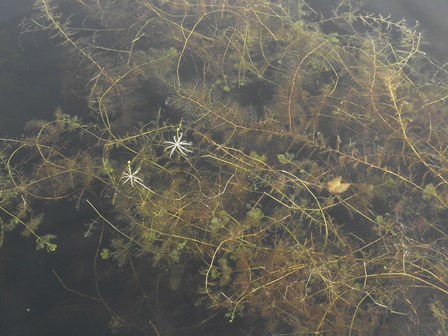Native Plant Growth – Just Something to Get Used To
Published in NH DES’s August The Sampler Newsletter
By: Amy Smagula, NHDES Exotic Species Program Coordinator
Aquatic plants are a common sight in New Hampshire’s waterbodies, and many lake residents, as well as visitors to New Hampshire’s numerous waterbodies, may question the importance and role of aquatic vegetation.
Each waterbody may vary in terms of the number, type and distribution of aquatic plants it supports. Over long periods of time, both diversity and distribution of those species can be expected to expand just a little bit, as the lake ages and more organic material accumulates on the lake bottom, making for ideal plant habitat.
Sometimes, on a shorter scale, one native plant species or another may become very abundant for a growing season, and then it is present in very low density the next year. Much like we see with acorn production or pine cone production from trees on land, native aquatic plants have “boom and bust” cycles as well. Usually those booms subside after just a season or two, and the native plants don’t sustain high levels of production for long duration. Bladderworts, native waterweed, water naiad and some pondweeds exhibit this boom and bust cycle. The summer of 2015 happens to be a good year for bladderwort growth statewide, and lots of lakes are seeing floating masses of bladderwort floating around like tumbleweeds. In 2014, it was water naiad that was the abundant species statewide, and in 2013 it seemed like pondweeds were taking off. Each of these have returned to their “normal” levels in waterbodies, and have not continually increased.

Native aquatic plants are not a bad thing in lakes, even though from our own human perspective they can sometimes be a nuisance. Aquatic plants provide many of the same functions as terrestrial plants. Aquatic plants provide a food source, fish habitat, remove carbon dioxide, and produce oxygen through photosynthesis. Plants act as the producers in an ecosystem since they produce their own food as well as food for the consumers or animals of that ecosystem. Aquatic vegetation provides food for tiny microscopic animals called zooplankton, fish, waterfowl, moose and other mammals, and in some cases humans.
Not all aquatic plants are nuisances which require removal. According to DES Wetlands staff, the removal of native aquatic vegetation from lakes and ponds is not allowed. The water, and the land underneath it, is state property and as such, the property owner does not have the legal right to make alterations to that land without a permit. Removal of native vegetation is considered to be habitat destruction. It should also be noted that the removal of native vegetation inevitably makes room for invasive vegetation to establish itself, further exacerbating a problem the state is already facing.
A permit would be required for any type of dredging and removing of sediment and/or vegetation and it’s not likely that such a permit would be granted for an individual property owner who simply wishes to have a swimming area on their waterfront that is free of vegetation. For questions about native plant management, please contact the DES Wetlands Bureau at 603-271-2147.